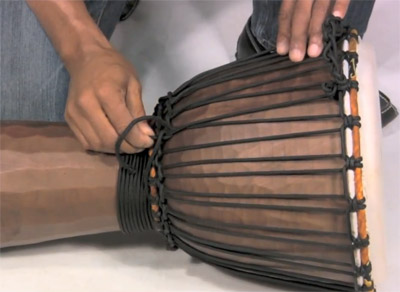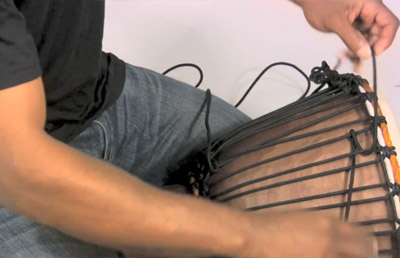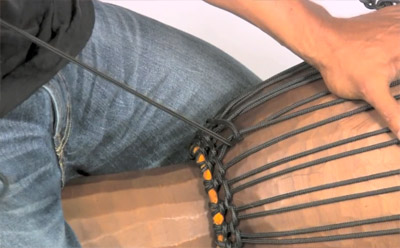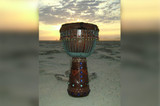How to Rope-Tune a Traditional Djembe
Understanding the Traditional Rope-Tuned Djembe
Djembe drums or djembes are primarily of two types - djembes with key tuning and rope tuned djembes. Rope tuned djembes are traditional as compared to their key-tuned, modern counterpart. Many players prefer the traditional rope-tuned djembe because they feel it has a more authentic and 'true to itself' sound. Others find the bolt or key-tuned djembes to be hard to play because of their metal rim that protrudes and causes hindrance while playing. But most beginners shy away from rope-tuned djembes thinking that tuning them is a complicated affair. Oddly enough, any newbie or beginner can easily pick up the nuances of tuning a rope-based djembe without any difficulty after just a few tries.
The aim of this article is to help you understand how to tune your rope-tuned djembe.
A rope-tuned djembe is the traditional design that has ropes around the head of the instrument that require tightening or loosening to tune it. Depending on the size or make of your instrument, there will be metal rings fitted around the head. These metal rings may be hard to spot because they are beneath the skin and are much smaller or thinner than what you would find in key-tuned djembes. You will also notice that these rings are fitted with rope runners that run vertically up and down the upper part of your djembe (known as the bowl). The djembe head has metal rings around it. These vertical rope runners are threaded onto the rings and are used to increase or decrease the tension of the drum head my tightening or loosening them. The tuning of your djembe depends on this 'tension' placed on the skin by the rope.
Tuning your instrument via rope is also called pulling diamonds. To tune the djembe you need to pull (or form) a diamond by placing horizontal knots on the different sets of vertical rope runners. This is called a Mali Weave.
How to make/pull/form a diamond on your Djembe Rope:

Firstly, locate where the extra rope (or lace) is because that is the place where the last diamond was formed (and even if it wasn’t, this is your starting point).
Your instrument should have extra rope wrapped around the drum or tied into a handle for the drum. If you do not see any extra rope then you will need to replace the entire rope system with longer rope. This process typically requires a professional to re-rope and set up the drum. Sometimes however the extra rope is woven into the existing rope and can be hard to spot for beginners. Check closely before resorting to re-roping.
Now locate the top ring where you have the extra rope and identify the next two adjacent laces that you will be using to pull a diamond. You will use an under-weave here.

Pass the extra rope under the two laces that you identified and then bring it back to pass under the first lace again. As you tug or pull on the extra lace, a diamond (shape) will appear to form.
Pull down to keep the diamonds regular. How many diamonds need to be pulled will depend on how much your djembe needs to be tuned. After you are done pulling, ensure that you tie off the rope at the end of it.
Here are a few things to keep in mind:
You can wear gloves to avoid any injury or bruises when pulling the rope.
Don’t and I repeat DON’T get tempted to pull ‘just one more’ diamond. Too much tightening will break the skin of the djembe and you will end up reskinning it.

If this is your first time then just do one or two to get the hang of it and undo them and start again for practice. If your instrument has never been tuned before, you should stop after a few diamonds and add knots every 10 days for two months.
There is no ‘ideal’ amount of diamonds and you will need to use your ear to determine how much tuning your instrument needs. Minor tuning can be anything from one to one dozen knots.
If your djembe has weak or wobbly bass sound with poor decay then you may even need to weave around the head up to four times. If this doesn't make a difference then you may be doing something wrong. Take a close look at our video tutorial on how to tune or get a djembe instructor to assist you. The most common mistake we see is that people do not pull the string hard enough so the diamonds are not as tight as they need to be to really produce added tension on the head. Having an instructor demonstrate the strength required to pull diamonds correctly can make all the difference.
Recent Posts
-
What is the Best Size Djembe for Beginners?
If you're new to the world of percussion and interested in learning the djembe, you're in for a t …16th Jul 2024 -
The Benefits of Becoming a Drumming Teacher: Transforming Passion into Profession
Why become a drumming teacher? Becoming a drumming teacher is an excellent way to share your pas …22nd May 2024 -
What Makes the Djembe Drum a Spiritual Instrument in African Music?
Origin and history of the Djembe drum The Djembe drum originates from West Africa and holds sign …16th May 2024



